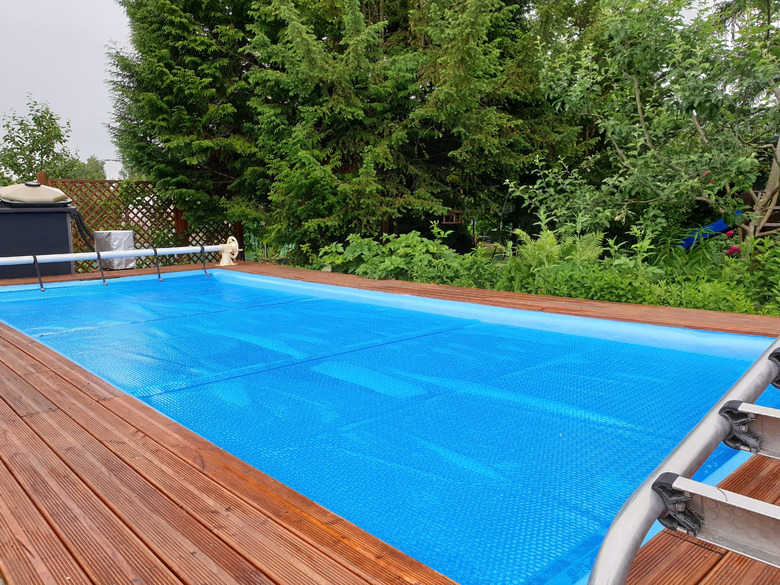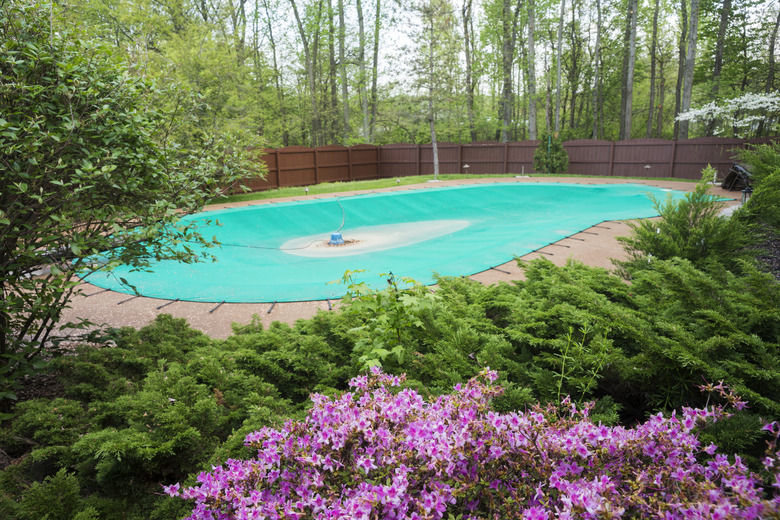Best Pool Covers For Your In-Ground Pool
We may receive a commission on purchases made from links.
There is no singular best pool cover that's ideal for every in-ground swimming pool. A cover that helps warm the water may not offer any safety protection when you've closed the pool for the day, for instance, but nearly all types of pool covers help keep the water free from debris while preventing some water loss through evaporation. To pick the right cover, consider what features are most important to you, such as safety or durability and then pick a model that offers the most features on your wish list that's in your price range.
Best Pool Cover for Safety
Best Pool Cover for Safety
Part of being a pool owner is being responsible both when you're actively using the pool and when it's in its off season. A safety pool cover helps prevent accidents that might occur should a person or animal fall into the swimming pool when the cover is on. Pool safety covers have the term "safety" directly in the description, as this is their primary purpose. A safety cover must hold at least 485 pounds per 5-square-foot area while in place over a pool in order to meet the safety standards set by ASTM International (or American Society for Testing and Materials). An ASTM-approved safety cover also offers some form of surface drainage, whether that means the cover itself offers some water permeability or that it has another means to control water runoff. This feature also helps prevent accidents.
A safety pool cover must not have gaps large enough to trap objects along the perimeter when the cover is in place. The perimeter area must also be able to withstand pressure so an object, such as a person's foot, won't slip between the pool and cover and become trapped. Safety covers must also be labeled to include safety and warranty information. The materials making up a safety cover are typically either mesh or a more solid structure; both types anchor around the perimeter of a pool in a way that the cover stays taut.
Mesh-style safety covers allow rain or melting snow to permeate the cover while keeping solid debris out of the pool water. This also eliminates potential puddles that might attract wildlife or young children. Mesh covers generally weigh less than solid pool covers. Solid covers do not allow water through, so they may not be ideal for heavy snowfall or heavy rain, as puddles may develop or even make the cover sag a bit. Many modern solid safety covers have mesh areas around the perimeter or, as a separate add-on accessory, a pump that sucks water off the cover to combat the potential puddling issue.
Solar Pool Covers
Solar Pool Covers
Besides keeping debris, such as insects and leaves, out of the water, a solar pool cover harnesses the sun's energy to warm the water beneath the cover. This helps reduce or even eliminate the energy costs needed to warm the water by other means, such as an electric heat pump or a gas-powered pool heater. Solar covers also help reduce water and chemical evaporation, which means less chemical and water replenishment are needed compared to not using such a cover (although other nonpermeable covers also help prevent evaporation).
As with other pool covers, solar covers come in assorted types, such as a solar blanket with bubbles that make it look like bubble wrap. The bubbles hold in warmth from sunlight if the cover is in place during daylight hours; at night, the bubbles help prevent heat loss in the pool. This type of cover essentially floats on the surface of the pool, covering the entire water surface, and is held down with water tubes that are sometimes used on winter covers. Solar-blanket-style covers vary in thickness; the thicker the cover, the better it is at keeping the water temperature warm. A solar blanket reel makes it easier to store the cover when not in use.
Solar rings are another form of cover that also float atop the water; in this case, several rings can be used in one pool to cover more surface area. These cover less area than the blankets (unless your pool is round and you find a solar ring that fits it perfectly), so they're a little less effective at preventing debris and at keeping the water warm. Solar rings are inflatable and need air to float atop the water; fill them with lung power as you would an air mattress or other type of pool float.
Both solar rings and blanket-style covers are designed for use during the swimming season. These are not winter covers and should be stored in a dry area out of the elements after the swimming season. You'll need a separate winter pool cover to protect the pool during the months that are too cool for outdoor swimming.
Winter Pool Covers
Winter Pool Covers
A winter pool cover, essentially a glorified tarp, keeps the pool water as clean and debris-free as possible during the off season. It also helps prevent water evaporation. As with safety covers, these come in either a permeable mesh or a nonpermeable, more solid material, but they offer no protection against anything or anyone falling atop the cover.
A mesh-style winter pool cover costs less than a vinyl, nonmesh version. The mesh allows moisture to pass through the cover. This means any snow accumulating on the cover eventually melts and becomes part of the pool water. The downside is that the pool water and probably the pool itself will need a lot more cleaning once swimming season nears since water traveling through carries dirt and tiny debris particles.
Solid vinyl winter pool covers generally last a few years less than their permeable mesh counterparts even though they cost more. They also require a pump on top to eliminate pooling water that accumulates after heavy rains or when snow piles melt. On the upside, they keep the pool water cleaner and even help block sunlight that contributes to algae growth. This is especially true with some insulated covers designed to block sunlight and keep the water warmer.
An inexpensive winter cover is better than no cover at all once you close the pool for the season, but it's not the best choice in most cases. If your pool is not in a fenced-in area or if children or pets that roam outdoors live in your home, a safety cover is a better option, even in winter. If you live in an area that gets heavy snow, opt for a cover that has at least a little mesh around its perimeter to allow melting snow to pass through. The safety cover is the best choice even with snow. If the entire yard is covered in several inches of snow, it could be hard to tell where the pool begins and ends, so animals or even people may accidentally walk on top of it. The safety cover prevents potentially harmful situations.
Automatic Pool Covers
Automatic Pool Covers
Automatic pool covers are ideal in that it's easy to "close" the pool after each day's swimming session, thus keeping the pool water free from debris and less inviting to unwanted guests, such as local wildlife during the open swimming season. The downside is that these are one of the most expensive types of covers, running $12,000 to $22,000 for installation due to all the equipment that must be installed to operate the cover. The average-quality manually operated safety cover costs less than half of that by comparison. An automatic cover requires electricity, as it has a drive mechanism powered by a motor to open and close the cover every day. Installing the electrical lines and the full automatic cover assembly is a project for a professional in most cases.
Operation of an automatic cover is done by turning a key, pushing a switch or button or using a coded keypad. As with garage-door openers, the means of pool cover operation can be set up for safety and security purposes so no unauthorized users (or children) can open the pool cover after you've closed it.
Both manual and automatic pool covers offer the same material options, such as mesh or vinyl, with the exception being the various floating solar pool covers. The only real difference otherwise is the means by which the covers are operated and secured over the pool. If your pool is large, such as greater than 18 x 36 feet, the best pool cover is an automatic one, as manually operated covers of this size are too bulky, even the manual type that rolls up on a spool via a hand crank. On the bright side, many manual pool covers can be converted to the automatic variety should you like the cover itself but tire of operating it every day.
Rolling or Sliding Deck Covers
Rolling or Sliding Deck Covers
At the absolute luxury end of all swimming pool cover options is the rolling or sliding mobile deck cover. This type of cover is an actual deck that covers the entire pool. The pool won't even be visible with the deck/cover over it, so there's no chance of someone or something falling in. When opening the pool, the deck maneuvers off to one end or side; some models are actually two pieces that open to opposite sides of the pool. Others feature pieces that nest beneath one another or that slide up a fence or wall when not in use. The most sturdy rolling deck is much like any deck and is able to support patio furniture and poolside lounge chairs.
Sliding and rolling deck covers are best for small to medium pools, as they're quite pricey, and most take up a lot of real estate when the pool is open. Even the least expensive automatic sliding deck cover costs upward of $25,000, but it's also not prone to tearing that could happen should a branch fall atop it, for instance. This type of cover could easily cost as much as installation of the pool itself.
Cover Cost Comparisons
Cover Cost Comparisons
In-ground pool cover costs vary greatly from one type to the next. The flimsiest, least expensive winter cover costs less than $50 or up to $350 for a more deluxe insulated version. Solar covers are also inexpensive, ranging from about $50 to $250. Both of these inexpensive cover options are not intended for security or safety purposes. Solar covers in particular do not last long and may deteriorate within a couple years. Even so, since they're inexpensive, they are a worthwhile investment if you enjoy naturally warmed pool water.
Safety pool covers are quite a bit more pricey, averaging from $1,000 to $3,000, although budget models and more elaborate ones also exist. The more durable and heavy-duty types could easily add $1,000 to the cost, which is also due to the springs or other mechanisms used to secure the covers. Automatic pool covers cost four to five times the price of a safety cover, while rolling-deck covers are easily 10 to 20 times the cost of a safety cover.
References
- Pool & Spa Depot: How to Choose the Right Inground Pool Cover
- BackyardCityPools: Safety Covers for Swimming Pools
- All-Safe Pool Fence & Covers: ASTM Pool Covers
- ASTM International: Standard Performance Specification for Safety Covers and Labeling Requirements for All Covers for Swimming Pools, Spas and Hot Tubs
- In The Swim: Solar Pool Cover Installation, Use and Care
- Latham Pool Products: Manual or Auto Pool Covers; Which Is Better?
- River Pools and Spas: Sliding Deck Pool Covers: Cost, Designs, Pros & Cons
- Royal Swimming Pools: Pool Safety Covers vs. Winter Pool Covers: Which Cover Should I Get?

